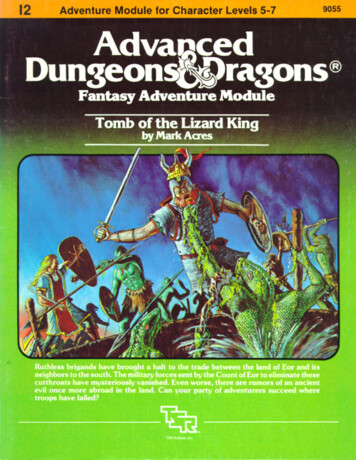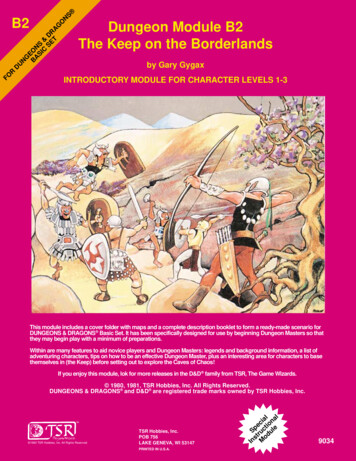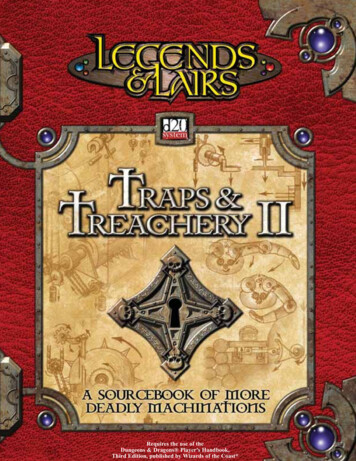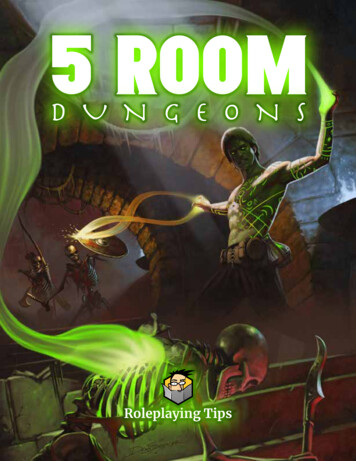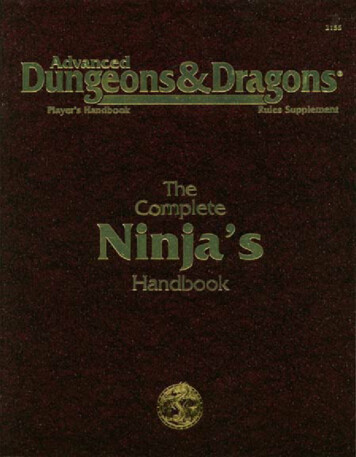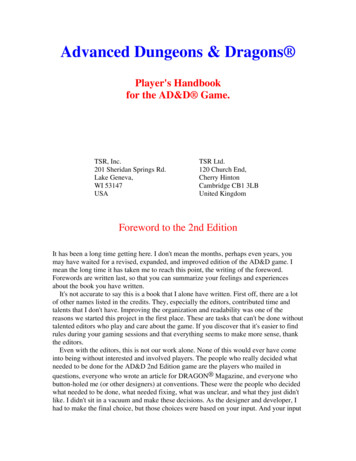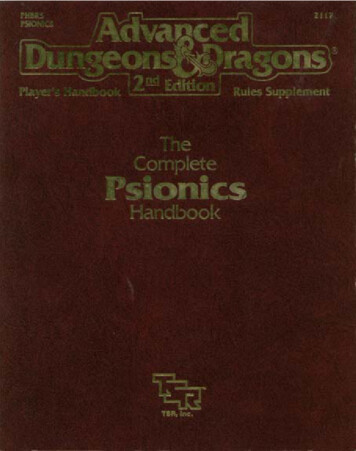
Transcription
nd Advanced Dungeons & Dragons 2 EditionPlayer's Handbook Rules SupplementPHBR5TheCompletePsionicsHandbookbySteve WinterCREDITSDesign: Steve Winter, with monster updates by Blake MobleyEditing: Andria Hayday
Black and white illustrations: Terry DykstraChapter illustrations: Dee BarnettColor photography (used with permission):page 1 by Lightscapes, The Stock Marketpage 9 by Ken Cooper, The Image Bankpages 45 and 77 by Steven Hunt, The Image BankGraphic design: Stephanie TabatTypography: Gaye O'KeefeProduction: Dee Barnett, Sarah FeggestadPlaytest coordination and liberal advice: Jon PickensPlaytesters: Rich Brewer with Allen Thomas, Mike Mlczeko.Arthur Collins with Phred Cain, Jason Davis, Jeff Pickett.Lee G. Irons with Andy Cohen, Matt Harrop, John Whitmer.Alan Grimes with Bob Bellamy, Leo Hallack, Shaun Horner, Jeff Kennedy, Mike Leibhart, SamOrlando, Tim Pontallion, Alex West.Caroline R. McBride with Brenda A. Floyd, Joe Floyd, R. Keith McBride, Sarah McBride, MaryE. Noah, Donnie Wolfgeher.Mark Middleton with David Boddorf, Tony Caine, Paul Conway, Jerry Harper, Ed Isaacs, LizNeese, Kip Romine.Jim Milan and William Tracy with Gay Milan, Jeff Stevens, Justin Stevens, Paul Stevens,Teresa Stevens, Jeff Wherry.Norm Ritchie with Linda Bingle, Mary Conczyk, Dewey Frech, Mark Hougaard, Jim Moeller, JayTummelson.TSR, Inc.POB 756Lake Geneva, WI 53147U.S.A.TSR, Ltd.120 Church End, Cherry HintonCambridge CB1 3LBUnited KingdomThis book is protected under the copyright laws of the United States of America. Any reproduction orunauthorized use of the material contained herein is prohibited without the express written permission of TSRInc.Distributed to the book trade in the United States by Random House, Inc. and in Canada by Random House ofCanada, Ltd.Distributed to the toy and hobby trade by regional distributors.AD&D, ADVANCED DUNGEONS & DRAGONS, FORGOTTEN REALMS, DRAGONLANCE and WORLD OF GREYHAWK are registered trademarksowned by TSR, Inc.RAVENLOFT, SPELLJAMMER, PRODUCTS OF YOUR IMAGINATION and the TSR logo are trademarks owned by TSR, Inc.Printed in the United States of America. Copyright 1991, TSR, Inc.ISBN 1-56076-054-0All Rights Reserved.2117The following alterations have been made in this electronic text from theoriginal:- The Table of Contents does not list page numbers;- The text reflects incorporation of errata published in The Will and The
Way:1 Psychokinetic DisciplinesThe following Devotions do not require Telekinesis as a prerequisite:Animate Shadow, Control Light, Control Sound, Molecular Agitation, Soften.2 Telepathic Disciplines- On page 75 the heading for the Fate Link power is missing.- Psychic Crush should be a devotion and Psionic Blast should be a science.- Ego Whip and Mind Thrust both require Contact as a prerequisite.- Telepathic defense modes have no prerequisites. A character does not needaccess to Telepathy to get Defense modes.- The Mindlink power is not a prerequisite for the following Devotions:Empathy, ESP, Identify Penetration, Incarnation Awareness, PsychicImpersonation, Send Thoughts.3 Metapsionic Disciplines- All references to Telepathic power (or prerequisite) should be changed toMindlink instead.4 Psionic Monsters listBrain Mole: References to the amplification power should be changed toPsychic Drain. Also, Mind Thrust is a Telepathic Power, not Metapsionic.Intellect Devourer (adult): References to the amplification power should bechanged to Psychic Drain. Also, Ectoplasmic Form should be listed as aDiscipline, not a Science.- Some minor alterations in the placement of various Tables have been madeto make the text more coherent in this format;- A minor correction was made to the Bibliography (the title of a book byZenna Henderson);- Some additions were made to the Bibliography;- The Thought Eater was moved to its proper place, after the Su-Monster.- The Summary of Powers and the Powers Index found at the end of the bookare not included here (redundant in this format);- Scattered typographical errors were corrected throughout the text.Text that is colored green (like this) is information obtained directlyfrom Mr. Steve Winter that clarifies certain aspects of the rules.No doubt, new errors were introduced. This document has been proofread andspellchecked several times in order to reduce the instance of new errors,as well as old errors that might have gone undiscovered. A great deal ofeffort was made to make this text as similar as possible to the original,printed version. I apologize for any errors that slipped through (pleasenote that, depending on the program you use to view this file, you may findcertain formatting “ errors” that will not show up in other programs. Forexample, this document was edited in MS Word; there are a substantialnumber of alterations in the tabs when this is viewed with WordPad, orWordPerfect).AN IMPORTANT NOTE:Much of the material presented in the AD&D 2nd Edition Dark Sun campaignsupplement, The Will and the Way, is considered to be officialsupplementary material for The Complete Psionics Handbook, except for thatmaterial which is stated to relate to Dark Sun only. Particularly, Chapter3 to the end can be considered supplemental to this book, with relativelyminor editing to remove Dark Sun references; Chapters 1 and 2 have almostno bearing whatsoever on this book.
Table of ContentsIntroductionWhat's Changed?How Does This Fit My Campaign?Is Psionics Magical?Chapter One: The PsionicistRequirementsAbility RequirementsPrime RequisitesRacial RestrictionsMulti-class CharactersDual-class CharactersRacial Level LimitsAlignmentOther QualificationsInitial FundsA Psionics PrimerPsionic Strength PointsPower ScoresPower ChecksAdvancementGaining DisciplinesGaining Sciences and DevotionsAdvancing Mid-adventureRaising Psionic Power ScoresPsionic Strength PointsGaining Psionic Strength PointsRecovering Psionic Strength PointsDefense ModesSpecial AbilitiesMaintaining PowersTHAC0 and Saving esThe Psionicist GroupWild TalentsDetermining PowersStrength PointsThe RisksChapter Two: Psionic CombatUsing PowersPower ChecksPsychic ContestsPsychic LockThe Combat RoundTelepathic CombatAttack ModesDefense ModesAttack ModifiersTangentsOther ConsiderationsLine of SightTouch AttacksCombat Cards
Sidebar: Understanding Power DescriptionsChapter Three: ClairsentienceClairsentient SciencesClairsentient DevotionsChapter Four: PsychokinesisPsychokinetic SciencesPsychokinetic DevotionsChapter Five: PsychometabolismPsychometabolic SciencesPsychometabolic DevotionsChapter Six: PsychoportationPsychoportive SciencesPsychoportive DevotionsChapter Seven: TelepathyTelepathic SciencesTelepathic DevotionsChapter Eight: MetapsionicsMetapsionic SciencesMetapsionic DevotionsChapter Nine: A Psionics CampaignLook What I Got!Burn Him!TSR's Campaign WorldsPsionics and MagicMonsters, Villains, and other NPCsLiving PsionicsKnights of the Floating TableRelated ReadingMonstersBakuBrain MoleCerebral ParasitesIntellect Devourer, adultIntellect Devourer, larva (ustilagor)SheduSu-MonsterThought EaterVagabondAppendicesMonstrous Compendium Update(Missing: Summary of Psionic Powers and Powers Index)Tables1: Racial Level Limits2: Experience Levels3. Individual Class Awards4: Psionic Power Progression5: Inherent Potential6: Psionic Strength Recovery7: Calculated THAC0s8: Saving Throws9: Armor Penalties10: Proficiency Slots11: Nonweapon Proficiencies
12: Wild Devotions13: Wild Sciences14: Attack vs. Defense ModesIntroduction"What do you think I am, a mind reader?"As a matter of fact, you might be, if you're an AD&D game character with theright stuff. All you need is brainpower, discipline, and The Complete PsionicsHandbook.Psionics - the practice of extraordinary psychic powers - was included in theoriginal AD&D game. Some players favored psionic powers; others found themconfusing. Psionics was not included in the AD&D 2nd Edition game.Now psionics is back by popular demand, and it's better than ever. Powersthis great may not be for everyone, so psionics is a completely optional additionto the AD&D 2nd Edition rules. But if you're ready to put mind over matter - totest the limits of inner space - then this book is for you.The Complete Psionics Handbook is not a reprint of the old psionics rules;it's a complete revision. If you remember the original AD&D rules, you'll findmuch that seems familiar here. Beware: old words may have new meaning. We'vekept a lot of the terminology, but changed the definitions. Read this bookcarefully before you assume an old rule still applies or jump to conclusionsabout what certain powers can or cannot do. What's Changed?This book contains five major revisions to the original AD&D psionics rules:1) The psionicist is a character class. Characters cannot pick up a psionicpower here and there just because they have a superior brain. Psionicists areextraordinary characters who develop their powers through arduous training (whilemembers of other classes may occasionally boast a psionic power or two, suchcharacters are mere shadows of true psionicists). An NPC psionicist has thepotential to stand his own against any other class. As a PC in a team ofadventurers, the psionicist will complement other classes well. Most of thepsionicist's powers are unique. He advances slowly, at a rate somewhere betweenthe fighter and mage. At low levels, however, the psionicist has the potentialto be powerful.2) The list of psionic powers is greatly expanded. Original rules includeda menu of 50 powers. This book has over 150.3) Psionic powers are organized differently. All psionic powers are groupedinto six disciplines: clairsentience (expanded senses), psychokinesis (movingmatter through space), psychometabolism (altering the body), psychoportation(psionic travel), telepathy (mind-to-mind contact), and metapsionics (an advanceddiscipline). Within each discipline are major powers, called “ sciences,” andminor powers, called “ devotions.”Characters can only learn powers from thedisciplines they have access to. At 1st level, a character has access to onlyone discipline, but with experience he gains access to more.4) Psionic powers are treated much like proficiencies. Psionic powers donot work automatically. A power is essentially a skill, and using it properlyrequires a power check.5) Psionic strength points are not divided into attack, defense, and genericbatches. All of a character's psionic strength points come from a single pool.Numerous other changes, both major and minor, have been made. To avoidconfusion, players are urged to read this book carefully.How Does This Fit My Campaign?
There's no reason why adding psionics to an existing campaign should disruptanything. As a class, psionicists are no more or less powerful than any other.Guidelines on how to introduce psionics without trauma are given in Chapter 9.Remember, everything in this book is optional; none of it is part of thecore of the AD&D game. If something in here doesn't suit a particular campaign,rule it out.Is Psionics Magical?Many people assume that psionics is just another type of magic. The AD&D gamealready has two types of magic - one wielded by wizards and the other by clerics.So it is not unreasonable to ask, "Does the game need a third type of magic?"The answer is no, the game probably does not need a third kind of magic.But the question is misinformed because psionics is not magic. Magic is theability to shape, control, harness, and utilize natural forces that infuse thegame world and surround the characters. It is based on the principle that,through the use of words, gestures, and catalyzing materials of unique power,these external energies can be controlled.The key element of that statement is external energy. Magical effects areproduced externally by manipulating outside forces. The power does not come frominside the wizard or priest but from somewhere else.Psionics is the complete opposite of this. The psionicist shapes, controls,harnesses, and utilizes natural forces that infuse his own being. His effort isfocused inward rather than outward. He must be completely in touch with andaware of even the tiniest workings of his body and mind.This type of knowledge comes from long and intense meditation coupled withphysical extremes. The psionicist finds enlightenment in both completeexhaustion and complete relaxation, in both pain and pleasure. The mind and bodyare only parts of a much greater unity. Indeed, discussing one without theother, as so many people do, seems nonsensical to a psionicist; they cannot beseparated. The body produces energy and vitality, the mind gives it shape andreality.Neither does the psionicist study or pray for his powers. He carries themwith him wherever he goes. As long as his mind and body are rested - i.e., aslong as he has not depleted his psionic strength - his powers are available tohim. Chapter 1: The PsionicistMore than a character of any other class, the psionicist is self-contained.Unlike the fighter and thief, he needs no weapons or tools to practice his art.Unlike the priest, he needs no deity. Unlike the wizard, he relies on no outsideenergies. His power comes from within, and he alone gives it shape.The psionicist strives to unite every aspect of his self into a single,powerful whole. He looks inward to the essence of his own being, and gainscontrol of his subconscious. Through extraordinary discipline, contemplation,and self-awareness, he unlocks the full potential of his mind.RequirementsThis section describes the requirements all characters must meet to become apsionicist, including restrictions based on ability scores, race, and alignment.The DM may waive these requirements in special circumstances, but playersshouldn't count on it.Ability Requirements:Constitution 11, Intelligence 12, Wisdom 15
Prime Requisites:Races Allowed:Constitution, Wisdomhuman, halfling, dwarf gnome, elf, half-elfAbility Requirements: To be eligible for the psionicist class, charactersmust have ability scores equal to or greater than those listed above forConstitution, Intelligence, and Wisdom.Prime Requisites: The pursuit of psionics requires strict mental andphysical discipline, so the psionicist has two prime requisites: Wisdom andConstitution.Wisdom - the measure of enlightenment and willpower - is the psionicist'sprimary mental characteristic, not intelligence. Reasoning and memory (twohallmarks of intelligence) are indeed crucial to this class. However, theessence of psionic ability is the understanding and mastery of the inner self.Although psionic powers are centered in the mind, acquiring and controllingthose powers demands physical fitness. Meditative study places tremendousphysical strain on the psionicist, not to mention the sheer drain of projectingpsychic energy out of one's body. The psionicist need not be muscular, or evenexceptionally strong, but he must maintain his health and fitness at a high levelto fully exercise his powers. That's why Constitution is also a prime requisitefor psionicists.Racial Restrictions: Humans, halflings, dwarves, and gnomes often have ahigh degree of psionic talent. Elves and half-elves also exhibit some naturalpsionic ability, but they are unable to pursue it to high levels.Multi-class Characters: As usual, only demihumans can be multi-classcharacters. Halflings and dwarves can combine psionics with other classes asshown below. Gnomes, elves, and half-elves cannot be multi-class psionicists;characters of these races develop their psionic powers at the expense of stthief/psionicistDual-class Characters: Humans can be dual-class psionicists within thenormal rules and restrictions for dual-class characters (see "Multi-class andDual-class Characters" in Chapter 3 of the Player's Handbook).Racial Level Limits: Humans can reach the highest possible experience levelas psionicists. Characters of other races have limits, as shown on Table 1.Because of their experience limitations, half-elf and elf psionicists are bestsuited as NPCs. Players who don't mind this "diminished potential" may stillplay such characters, however (the DM may amend these level restrictions forcharacters with exceptionally high Wisdom and Constitution scores; see theoptional rule under "Exceeding Level Limits" in Chapter 2 of the Dungeon Master'sGuide).Table 1:PSIONICIST RACIAL LEVEL LIMITSHalflings 10Gnomes9Dwarves8Half-elves 7Elves7Alignment: Psionicists have only one alignment restriction: they cannot bechaotic. Discipline is the foundation of all psionic power. A character whosecreed is chaos cannot achieve the level of self-control that psionicists require.This restriction applies to a character who becomes chaotic for any reason.Such a character will quickly lose his psionic powers. Every day in which hisalignment is chaotic, the character must make an ability check against one-halfof his Wisdom score, rounded down. Each time he fails one of these Wisdomchecks, the character loses access to one of his disciplines, selected randomly
by the Dungeon Master. Furthermore, a chaotic character cannot recover psionicstrength points. (Disciplines and psionic strength points are explained below.)If the character's alignment returns to normal - or even to another, non-chaoticalignment - he can recover his disciplines, one per day, by successfully makingthe same halved Wisdom check.Other Qualifications: If a character meets all the requirements above, andthe player wants to play a psionicist, the PC is assumed to exhibit psionicpotential. Nothing else is required.Initial FundsWhen psionicist characters begin play, they have 3d4x10 gold pieces.usual, skill and luck will determine what they make of it.AsA Psionics PrimerAll psionic powers belong to one of six disciplines: clairsentience,psychokinesis, psychometabolism, psychoportation, telepathy, and metapsionics.Within each discipline are major powers, called sciences, and minor powers,called devotions.Clairsentient powers allow characters to gain knowledge that is beyond thenormal capacity of human senses. For example, some clairsentients can see andhear events that are miles distant, while others can sense poison.Psychokinetic powers move objects - from molecules to missiles - acrossspace. A psychokineticist can throw a rock without touching it, or agitatemolecules in a piece of paper until it bursts into flame.Psychometabolic powers affect the body. Biofeedback, healing, and shapechanging are just a few of the powers known.Psychoportive powers move characters or creatures from one location toanother without crossing space. The traveler simply ceases to exist in onelocation, and begins to exist somewhere else. He may even travel to anotherplane of existence or to another time.Telepathic powers involve direct contact between two or more minds.Examples include mind reading, personality swapping, and psychic attacks.Metapsionic powers amplify, augment, or enhance other psionic abilities.This is an advanced, demanding discipline.Psionic Strength Points: Characters use psionic powers much likeproficiencies, with a few significant differences. Every time a psionicist usesa psionic devotion or science, he must pay its "cost." This cost is deducted fromthe character's total psionic strength points, or PSPs. PSPs are similar to hitpoints, except that the psionicist spends them willingly, and he can recover themmuch faster than lost hit points (psionic strength points are explained morefully in a section below).Power Scores: Like a proficiency, every psionic power that a character knowshas a score. In other words, a psionic power score represents the character'saptitude in using that particular power. Power scores are devised exactly likeproficiency scores. Every psionic power is associated with one of thecharacter's basic attributes (Strength, Wisdom, etc.). The psionic power scoreequals the character's score for that attribute, plus or minus a specific amount.For example, a psionic power with a score of "intelligence -3" has a score threeless than the character's intelligence.Power Checks: When a character wants to use a psionic power, the playermakes a psionic power check by rolling 1d20. If the number rolled is equal to orless than the power score, the character succeeds (in other words, he does whathe intended). The player subtracts the cost of the power from his character'stotal pool of psionic strength points.If the roll exceeds the psionic power score, it means the character tried touse his power, but failed. Failure has a price. The player must subtract halfthe cost of the power, rounded up, from the character's psionic strength points.In most cases, the psionicist can try to use the same power again immediately (inthe next round). For exceptions, see the individual power descriptions in this
book.Like a proficiency check, a psionic power check yields specific results on adie roll of 20 or 1. A "20" always indicates failure. A "1" always indicates aminimum level of success, regardless of the character's power score. In otherwords, even if a character's score has been reduced to a negative number bypenalties, a roll of "1" still succeeds. That doesn't mean a "1" (or any lownumber) is the best result. A "1" means the power works - but often with a quirkor drawback. See the individual power descriptions for specifics.Players may use the optional "skill score" rule for psionic powers, too. Ifthe die roll for the power check equals the character's power score, specialresults occur. Chapters 3 through 8 provide the details.AdvancementExperience Levels and Awards: A psionicist earns experience points andadvances in level just as members of other classes do. Table 2 outlines apsionicist's advancement.The Dungeon Master's Guide includes an optional rule for individualexperience awards (see DMG Chapter 8). Table 3 expands that rule to includepsionicists.Table 2: PSIONICIST EXPERIENCE 3,000,000HitDice (d6)1234567899 29 49 69 89 109 129 149 169 189 209 22Table 3: INDIVIDUAL CLASS AWARDSPsionic power used to overcome foe or problem:10 XP/PSPPsionic power used to avoid combat:15 XP/PSPDefeat psionic opponent:100 XP/level or hit diceCreate psionic item:500 XP x levelGaining Disciplines: Every psionic power belongs to one of the sixdisciplines listed previously. Before a character can learn a psionic power, hemust have access to the appropriate discipline. Psionic characters begin playwith access to only one discipline. As they progress to new experience levels,they gain access to additional disciplines. Table 4 shows how many disciplines acharacter has access to at each experience level.Table 4: PSIONIC POWER PROGRESSION
Discipl. TotalDef.Devotions 25235245255Gaining Sciences and Devotions: Every new, first-level psionicist knows fourpowers within a single discipline: one science (major power) and three devotions(minor powers). With each new experience level, a psionicist gains new powers.Sometimes he gains both sciences and devotions; at other times, only devotions(see Table 4).A player can select new powers for his character as soon as the psionicistreaches a new experience level. These new powers can be chosen from anydiscipline the character can access, including a discipline that was just gained.However, a psionicist is not compelled to fill a power slot with a powerimmediately upon advancing a level. Psionic powers, in this respect, are justlike proficiencies. Note that psionicists who leave a power slot unfilled maysuffer from experience penalties: A psionicist with unfilled power slots suffersa 5% decrease in earned experience until those slots have been filled (this isdue to a slackening of the discipline that is so important to a psionicist).Note: If the optional training rule is in play, characters must train with amentor until they reach 7th level. To find the training time in weeks, subtractthe mentor's Wisdom score from 21. Beyond 7th level, psionicists can trainthemselves if they pass the necessary checks to qualify as instructors. Thetraining time for a psionicist instructing himself is doubled.Players must follow two simple rules when choosing new powers for theircharacters:Within a single discipline, the number of devotions that a character knowsmust be at least twice the number of sciences.The first discipline chosen is the character's primary discipline. Acharacter can never learn as many sciences or devotions in another discipline ashe currently knows in his primary discipline.Example: Lena's primary discipline is clairsentience. She knows three sciencesand seven devotions in that discipline. This means: a) she must learn an eighthclairsentient devotion before she can learn a fourth clairsentient science, andb) at her current level, she cannot know more than two sciences or six devotionsin any other single discipline.Advancing Mid-adventure: Most Dungeon Masters award experience points at theend of adventures rather than in the middle, so experience levels are rarelygained in midadventure. In the unusual event that a new level is gained in themiddle of an adventure, however, the character should have to wait at least untilhe has a chance to rest and recuperate - long enough to recover all his psionicstrength points - before gaining any new psionic powers.Raising Psionic Power Scores: A character can increase a psionic power score
when he reaches a new experience level by "relearning it" (he repeats hisstudies, and learns something new about a familiar power). Instead of learning anew devotion, the character can add one point to his power score in a devotion healready knows. Similarly, he can exchange a new science for a one-point increasein a science he already knows.Psionic Strength Points (PSPs)Psionic energy comes from within the character. This energy is measured inpsionic strength points, or PSPs. When a character uses a psionic power, heexpends psionic strength points. The exact cost depends on which power is used,and how long the character uses it. Note that PSPs cannot be lost because ofsleep or unconsciousness; they can only be expended or drained (see variousPowers and Monsters).The total number of psionic strength points that a character has depends onfour factors: his Wisdom, Intelligence, and Constitution scores, and hisexperience level. Wisdom, Intelligence, and Constitution determine thepsionicist's inherent potential (Wisdom is the primary factor). Experiencedetermines how well the character has developed that potential.Follow these steps to calculate a character's total PSPs:1) Find the character's Wisdom score on Table 5, then get his base scorefrom that.2) Add the appropriate ability modifiers for the character's Intelligenceand Constitution scores to his base score. This final adjusted number is thecharacter's inherent potential.Example: Rowina's ability scores are Wis 17, Con 16, Int 12. Her inherentpotential is 25 (24 points for her Wisdom score with a 1 modifier for herConstitution score). At 1st level she has 25 PSPs.Table 5: INHERENT ityModifier0 1 2 3Gaining Psionic Strength Points: Every time a character advances to a newexperience level, he expands his total pool of psionic strength points. Todetermine how many PSPs he gains, find the modifier on Table 5 that correspondsto his Wisdom score. Add this number to 10. The result equals the total PSPsgained.Example: Rowina has just advanced to a new level. Her Wisdom is 17.According to Table 5, the modifier for this score is 2. Rowina can add 12 PSPs(2 10) to her total pool.Recovering Psionic Strength Points: A character who has expended psionicstrength points can recover those points by "taking it easy" - which meansengaging in no hard physical activity and refraining from using psionic powers(i.e., from expending any more PSPs). After each hour in which a characterexpends no psionic strength points, check Table 6 to determine how many PSPs thecharacter recovers. A character can never recover more PSPs than he lost.A character's rate of recovery depends on how much physical exertion heexperienced during the hour in question. Psionicists recover the most pointswhen they sleep or meditate for the entire hour of rest. Light activity, such aswalking or riding, diminishes the speed of recovery. Rate each hour according tothe most strenuous physical activity undertaken, even if it lasted only a fewminutes.Option: DMs may allow characters to recover points per turn of rest ratherthan per hour. These rates are also listed on Table 6.
Table 6: PSIONIC STRENGTH RECOVERYPhysical ActivityPSPs RecoveredHard exertion*noneWalking, riding3/hour (1 every 2 turns)Sitting, resting, reading 6/hour (1/turn)Rejuvenating**, sleeping12/hour (2/turn)* "Hard exertion" includes fighting, running, digging ditches, walking whileencumbered, climbing a rope, scaling a mountain, exploring a dungeon, swimming,and any other activity the DM wants to include.** This refers to use of the psionicist's Rejuvenation proficiency.Defense ModesPsionic defense modes are special powers which all psionicists acquirenaturally in time. All defense modes belong to the telepathic discipline.Psionicists learn these powers automatically as they gain new experience levels regardless of whether or not they have access to the telepathic discipline.Defense modes do not count toward the psionicist's maximum number of powers aslisted in Table 4. Nor are they counted when characters determine the relativenumber of sciences and devotions they can acq
Advanced Dungeons & Dragons 2nd Edition Player's Handbook Rules Supplement PHBR5 The Complete Psionics Handbook by Steve Winter CREDITS D



